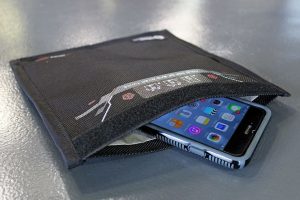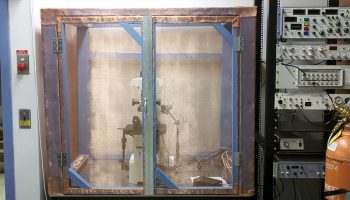![Homemade Faraday cage: By UofA RFV (Own work) [CC BY-SA 3.0 (http://creativecommons.org/licenses/by-sa/3.0)], via Wikimedia Commons](https://selfreliancecentral.com/wp-content/uploads/2015/05/Home-made_Faraday_cage-300x171.jpg)
Five years ago, we almost lost everything. Our entire power grid nearly fried.
In 2012, our solar system experienced an extreme solar storm—the most powerful solar storm in more than 150 years. The storm missed us – narrowly. If it had hit, we’d be living in a different world today.
According to experts, if that solar storm had occurred just one week earlier we would still be picking up the pieces. It would have knocked out all electric-based communications. The internet and cell phone networks would have experienced widespread, probably total, outages. It would have knocked out transformers and power substations, collapsing our nation’s grid.
Without reliable power or communications, our economy would just stop dead. Experts estimate around $2 trillion to repair the damages. Never mind how much we would have lost in productivity. And millions would die. Think how dependent we are upon electricity, especially in the high-rise city where all our heating, cooling, water supply, waste disposal (think toilets) depends upon power. Disease, accidents, stress would all create patients for a system utterly unable to cope.
If you live in the ‘burbs or a rural location you could handle life without power a little differently. You have room for a fire, to dig a trench for a toilet, to launder outside. But how about you protect a few devices for when the world is getting back to normal — especially communications devices? And especially off-the-grid devices like a ham radio.
How to Protect Essential Electronics
If you tell someone you plan to build a Faraday cage, you’re likely to get a raised eyebrow in response. In some cases, even an eye roll.
But don’t let that discourage you. Chances are the person shooting you the “He’s at it again,” looks doesn’t realize that he already uses Faraday cages in his everyday life.
A Faraday cage is a method of protecting electronic circuitry from sudden surges in electrical radiation. The typical cage is designed to prevent damage from radiation surges that are moving through the atmosphere and not just over existing power lines.
In essence a Faraday cage is a sealed box that’s been covered in metal. An electronic device placed within the box that isn’t in direct contact with the sides of the box, will be protected from surges.
While that may sound like a new concept, it really isn’t. In fact, I’m willing to bet that you’ve probably used a Faraday cage at least once in the last month without even realizing it.
If you ever use a microwave oven, for example, you’re using a Faraday cage. A microwave oven is a Faraday cage. It just has other functions. The cage works to trap radiation in the microwave. Otherwise, we’d all get zapped every time we made popcorn.
Imagine not having any electricity for days, weeks, months or even years… no lights, no communication channels, no water, no refrigeration, no navigation systems, no gas pumping, no food transportation, no waste pumping or garbage collecting. Former CIA director James Woolsey says “two thirds of US population would die”. No one in our country can survive something like this. Imagine what would happen if people only knew OUR NATION’S POWER GRID IS RATED A D+.
It’s good to note that microwaves will keep radiation out, too. Some police departments are actually using microwave ovens to protect seized iPhones while they wait for a search warrant (as per the recent Supreme Court ruling). Popping the phone in a microwave and closing the door protects the phone from anyone attempting to remotely erase its data or fry its circuits.

Many modern-day buildings have rooms that act as Faraday cages—especially buildings in industries that demand high digital security.
Even your car acts as a sort of Faraday cage. In the event of a lightning strike, the metal exterior will absorb and redirect the current, keeping you safe inside. That’s in essence how a Faraday cage works. But a true Faraday cage protects from all types of radiation … not just lightning strikes.
A Simple Answer to a Solar Storm
Obviously, building a Faraday cage in your garage won’t protect the entire grid. But it can protect some essential items that will make it much easier for you to survive and even thrive in the aftermath of such a disaster.
Say, you have a tablet, for example. And on that tablet, you have a wealth of information from basic digital textbooks on physics and chemistry to a series of articles on local gardening to basic first aid instructions to whatever other information you want to store.
Outside of a Faraday cage, during an EMP or solar storm that tablet is toast. Keep it inside the cage, and you’ll have all that information at your fingertips even if the power and the Internet is down.
Other things you might consider for your Faraday cage include:
- Walkie-talkies – good for home security
- Hand-crank radio – essential for staying informed
- Solar battery charger – that tablet isn’t going to power itself
- 12V to 110 inverter – for connecting your battery to whatever needs power
- Power tools – you may need to build something
- Your back-up hard drive – we keep our lives on our computers. It’s good to make a copy.
Now, how to build your own Faraday cage. This part is actually pretty simple.
What you’ll need:
- A metal box of some sort – an old filing cabinet is a good option. Whatever you use has to be metal on every surface or it won’t work.
- Some insulated packing material – Styrofoam works great.
- Some fine copper mesh.
- A soldering iron.
What to do:
- Put the insulated packing material inside the metal box.
- Place your items inside the box. Make sure they’re protected from the sides of the box by the packing material.
- Close the box.
- Cover any gaps in the container’s metal sides with the copper mesh.
- Solder the mesh in place.
- Put a battery-powered radio inside, turned on. If you can hear it, you have a leak. Reinforce until you can’t hear it any more.
That’s it! You’re done. If that’s too much trouble, you can always find a large old microwave and keep your electronics in there. Just make sure the door still has a good seal.
We had a near miss just two years ago. We may not be so lucky next time. So, take a day to secure a few critical electronic items within a homemade Faraday cage. In the event of an EMP attack or solar storm, you will be very glad you did.

